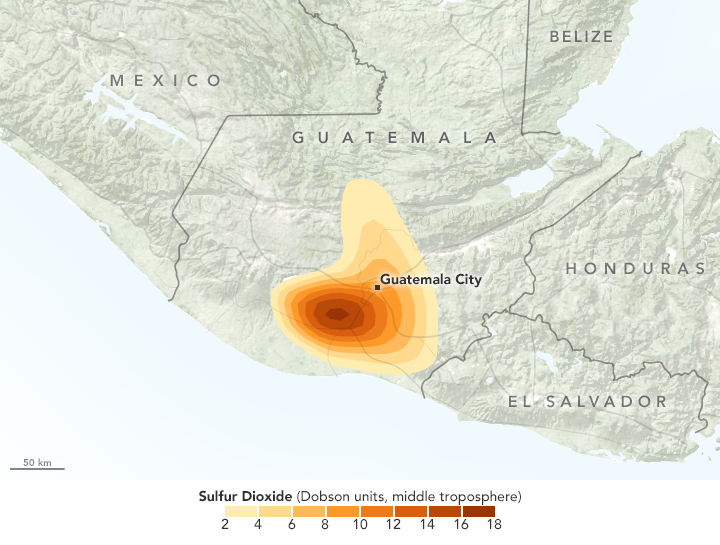Archive for June, 2018
Sri Lanka health officials have reported an increase in the number cases of leptospirosis
Thursday, June 14th, 2018“…..From Jan-May 2017, authorities reported 1,022 cases; however, for the same period in 2018, 1,525 cases were reported.….”


Thailand: A suspected MERS patient from a Middle Eastern country has been quarantined at the Bamrasnaradura Infectious Diseases Institute in Nonthaburi
Thursday, June 14th, 2018NASA: Volcán de Fuego
Thursday, June 14th, 2018Fuego in Guatemala is one of Central America’s most active volcanoes. For years, the towering Volcán de Fuego has puffed continuously, punctuated by occasional episodes of explosive activity, big ash plumes, lava flows, and avalanche-like debris slides known as pyroclastic flows.
Just before noon on June 3, 2018, the volcano produced an explosive eruption that sent ash billowing thousands of meters into the air. A deadly mixture of ash, rock fragments, and hot gases rushed down ravines and stream channels on the sides of the volcano. Since these pyroclastic flows often move at speeds of greater than 80 kilometers (50 miles) per hour, they easily topple trees, homes, or anything else in their path. According to news reports, more than two dozen people were killed. As a precautionary measure, thousands of other people have been evacuated.
The Visible Infrared Imaging Radiometer Suite (VIIRS) on Suomi NPP acquired this image of the ash plume at 1 p.m. local time (19:00 Universal Time) on June 3, 2018, after the ash (brown) had punched through a deck of clouds. A report from the Washington Volcanic Ash Advisory Center estimated the plume’s maximum height at 15 kilometers (9 miles). Imagery from a geostationary satellite showed winds blowing the plume to the east. The eruption deposited ash on several communities surrounding the volcano, including Guatemala City, which is 70 kilometers (40 miles) to the east.
In addition to ash, the plume contains gaseous components invisible to the human eye, including sulfur dioxide (SO2). The gas can affect human health—irritating the nose and throat when breathed in—and reacts with water vapor to produce acid rain. Sulfur dioxide also can react in the atmosphere to form aerosol particles, which can contribute to outbreaks of haze and sometimes cool the climate.
Satellite sensors such as the Atmospheric Infrared Sounder (AIRS) on the Aqua satellite and the Ozone Mapping Profiler Suite (OMPS) on Suomi NPP make frequent observations of sulfur dioxide. The map above shows concentrations of sulfur dioxide in the middle troposphere at an altitude of 8 kilometers (5 miles) as detected by OMPS on June 3.
Upon seeing data collected by AIRS several hours after the eruption that showed high levels of sulfur dioxide in the upper troposphere, Michigan Tech volcanologist Simon Carn tweeted that this appeared to be the “highest sulfur dioxide loading measured in a Fuego eruption in the satellite era.”
-
References
- Discover (2018, June 4) Rocky Planet: Deadliest Eruption of 2018. Accessed June 4, 2018.
- NASA Global Sulfur Dioxide Monitoring Home Page. Accessed June 4, 2018.
- Smithsonian Institution Global Volcanism Program (2018) Fuego. Accessed June 4, 2018.
- The New York Times (2018, June 4) Guatemala’s Fuego Volcano Erupts, Killing at Least 33. Accessed June 4, 2018.
- U.S. Geological Survey Pyroclastic flows move fast and destroy everything in their path. Accessed June 4, 2018.
- Volcano Discovery (2018, June 4) Fuego volcano news & eruption update. Accessed June 4, 2018.
NASA Earth Observatory images by Joshua Stevens, using VIIRS data from the Suomi National Polar-orbiting Partnership and OMPS data from the Goddard Earth Sciences Data and Information Services Center (GES DISC). Story by Adam Voiland.
- Instrument(s):
- Suomi NPP – VIIRS
- Suomi NPP – OMPS
Pfizer announces it will extend its donations of Zithromax to treat trachoma for five years.
Thursday, June 14th, 2018“…….Pfizer has announced it will extend its donations of antibiotics to treat the debilitating eye disease trachoma for five years.
Pfizer initially said its donation of the drug Zithromax would end in 2020, the target for the worldwide elimination of the disease. Now it has said that the drugs will be available until 2025 “to help all endemic countries reach their targets”……”
Monsoon rains set in over the weekend in Bangladesh, flooding Rohingya refugee camps
Thursday, June 14th, 2018“……a Rohingya boy….died when a mud wall of his shelter fell on top of him…..His mother also was injured in the collapse…..”
Wildfires in Colorado
Wednesday, June 13th, 2018- evacuation of more than 1,300 homes Tuesday
- spreading dangerously close to the resort town of Silverthorne
- getting close to two densely populated housing developments, just 60 miles west of Denver.

IMSR Summary
June 12th, 2018
New large incidents: 3
Large fires contained: 8
Uncontained large fires: 21
Area Command teams committed: 0
NIMOs committed: 0
Type 1 IMTs committed: 3
Type 2 IMTs committed: 2
Source:
Incident Management Situation Report

Spain accepts Mediterranean refugees that Italy’s new government rejected,
Tuesday, June 12th, 2018Kabul, Afghanistan: A suicide bomber kills 13 and wounds 25 more during rush hour on Monday.
Tuesday, June 12th, 2018“……….In April, two explosions in Kabul killed at least 26 people, including nine journalists who had arrived to report on an initial blast and were targeted by a suicide bomber.
A week earlier, 60 people were killed and more than 100 wounded when a suicide bomber blew himself up outside a voter registration center in the city…..”






